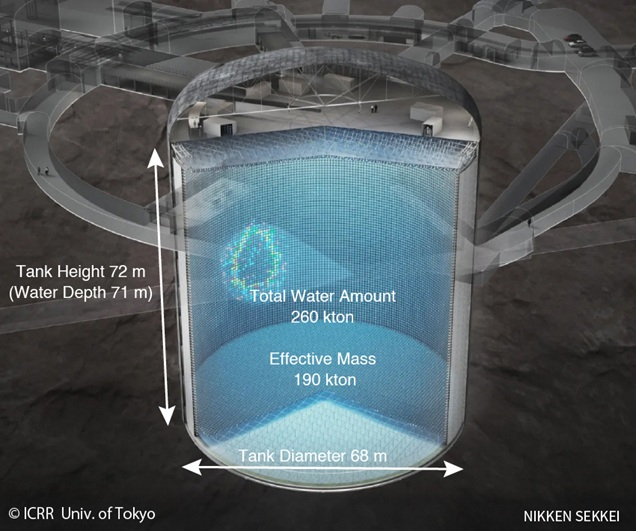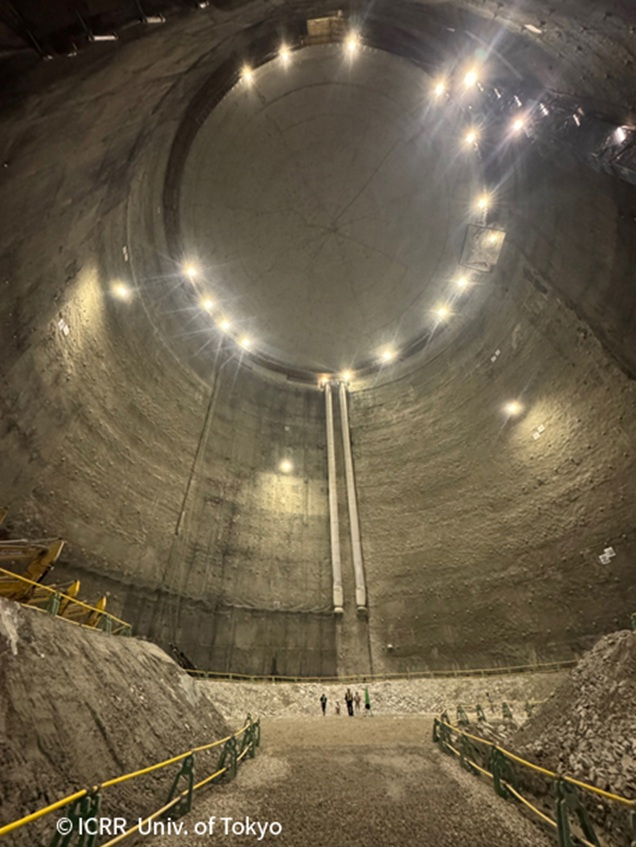Research News
Aug 27, 2025
- Science
Excavation Milestone Reached for Japan’s Next-Generation Neutrino Detector
Excavation of the massive underground cavern that will house the main detector of the next-generation, large-scale water Cherenkov neutrino observatory, Hyper-Kamiokande, was completed on July 31, 2025, after almost three years. This represents an important step in making the observatory operational.
The Hyper-Kamiokande aims to study the neutrinos that served an important role to make up the universe and test key hypotheses about the nature of matter itself. Led by the University of Tokyo and the High Energy Accelerator Research Organization, the project brings together about 630 researchers from 22 countries, including scientists from Osaka Metropolitan University.
The project officially launched in February 2020, utilizing an abandoned mine located 600 meters beneath the mountains of Hida City, Gifu Prefecture. The site sits within the Gneiss Area of the Hida Metamorphic Zone, one of Japan’s hardest rock formations. Before beginning the main excavation, researchers conducted extensive geological surveys, including over 730 meters of drilling. Based on the results of the geological surveys, engineers carefully planned both the shape of the cavern and the reinforcement methods.
The team decided on a dome-shaped upper section, measuring roughly 69 meters in diameter and 21 meters high, atop a cylindrical lower section of about 73 meters tall. Together, they form one of the largest man-made underground caverns ever carved from solid bedrock. The dome was specifically designed to withstand immense geological pressure through a three-dimensional arch effect.
Beginning in November 2022, workers accessed the top via a temporary spiral tunnel, gradually expanding the space outward while securing the ceiling with shotcrete and anchors. Excavation of the cylindrical section followed in October 2023, completing the massive underground structure piece by piece. Midway through the work, the construction crew had to carry out large-scale wall reinforcement using scaffolding, which added to the work.
To speed up the removal of blasted rock, workers first drilled a 3.4-meter-wide vertical shaft at the center of the site, connecting it directly to the base tunnel. The shaft was used to transport the rocks using dump trucks. Even so, the massive task of excavating the 330,000-cubic-meter main cavern was successfully completed on July 31, 2025, six months later than originally planned.
Starting in August 2025, construction of the water tank designed to hold 260,000 m3 of ultra-pure water will begin in the main cavern. The massive water tank will have an effective volume about eight times larger than that of the existing Super-Kamiokande. The water is an essential part of Hyper-Kamiokande activities because neutrino interactions in water produce Cherenkov light, an extremely short flash of light that allows these rare events to be detected.
In 2026, assembly of internal structural components to support the two-layer detector system will start, followed by the sequential installation of photodetectors and other devices. The new facility boasts over 20,000 new-generation photodetectors, which will be mass-produced in collaboration with partner institutes overseas. When a neutrino interacts with water and produces Cherenkov light, these detectors will capture the faint flashes of photons. By recording the timing, intensity, and pattern of light using photodetectors, researchers can reconstruct the type, energy, and direction of incoming neutrinos.
Meanwhile, at J-PARC in Tokai Village, Ibaraki Prefecture, upgrades to boost the intensity of the neutrino beam as well as construct a near detector are underway. By through precision measurements of neutrinos and searches for proton decay, the project aims to unravel the mysteries of cosmic evolution and test grand unified theories.
Installation of all equipment is scheduled to be completed in 2027. After filling the tank with ultra-pure water, observations are expected to begin in 2028. Throughout the process, the research group at Osaka Metropolitan University is playing an active role in the construction of the detector and has a leading position in managing and overseeing the construction.
Their project aims to test the hypothesis created by the T2K experiment that neutrinos exhibit CP violation near the maximal value, which could help explain the matter–antimatter imbalance in the universe. Hyper-Kamiokande aims to test this hypothesis within about three years of starting operation. This discovery would provide us with key insights to solving the fundamental question of why matter exists in the universe.

Figure 1: Conceptual diagram of the water tank for the completed Hyper-Kamiokande detector.

Figure 2: The cavern that houses the Hyper-Kamiokande is one of the largest man-made underground caverns in the world, measuring 69 meters in diameter and 94 meters in height.
Reference
https://www.u-tokyo.ac.jp/focus/en/articles/z0208_00226.html
Contact
Kazuhiro Yamamoto
Graduate School of Science
Email: kazuhiro[at]omu.ac.jp
*Please change [at] to @.
SDGs

